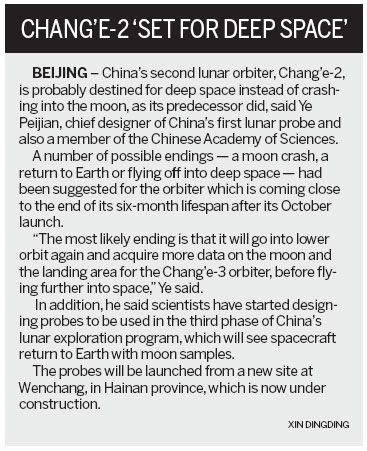Top News
'Smart' Mars probe will boldly go on trek
Updated: 2011-03-02 07:36
By Xin Dingding (China Daily)
|
|
Mission plan being drafted as nation sets eyes on 'Red Planet'
BEIJING - China will update and modify its lunar probes to develop a Mars probe, Ye Peijian, chief scientist of deep space exploration at the China Academy of Space Technology, told China Daily.
Modifications, to enable the Mars probe to reach deep space and become "smarter", will be carried out, said Ye, who is in charge of drafting a technical plan for exploration of the "Red Planet", which has yet to get government approval.
Ye, a member of the Chinese Academy of Sciences, believes exploring the planet is the inevitable path for China, a growing space power.
"In the last century, lunar landings and exploration were the priority, but the trend has reversed this century," he said.
The China Academy of Space Technology, designers of the Shenzhou spacecraft and lunar probes, is trying to draft a technical plan for Mars exploration.
The Mars probe will be "intelligent" enough to detect faults and correct them by itself, and able to navigate without relying on commands sent from Earth.
This self-reliance is important due to the distances involved, Ye said. "Mars is so far away from us - from 55 million km to 400 million km depending on its orbit - and signals need a longer time to transmit. Relying on commands from Earth will be impossible."
A signal sent from Earth to Mars will take at least 20 minutes. "When scientists detect something wrong and try to correct it, the time needed to send signals will make it impossible to correct mistakes in time," he said.
This "smart" ability will be vital when the probe uses the planet's gravity to enter orbit, a maneuver that requires the probe to adjust its speed and use the gravitational pull to ensure the correct path.
"Due to the time delay in communications, it would be impossible for us to know the exact position of the probe to maneuver it to enter the preset orbit," he said.
No such communication gap exists in the moon program, as transmissions to a lunar orbiter only take a second, and scientists can accurately maneuver a probe to ensure its correct orbit.
But developing a "smart" probe is not the only major hurdle, he said.
Another obstacle to be overcome involves establishing a monitoring network for deep space, consisting of large-caliber antennas and communication facilities, which China is currently constructing.
Qian Weiping, chief designer of the lunar probe Chang'e-2 mission's tracking and control system, said in January that the network will be completed in 2016, according to media reports.
The network will be composed of two monitoring stations in China and one in South America, Qian said.
Upgrading work for the two monitoring stations in China's northwestern region of Kashgar and northeastern region of Jiamusi will be completed in 2012, allowing them to be operational for lunar orbiters, Chang'e-3 and Chang'e-4, Qian said.
The station in South America will be set up in 2016, Qian said.
According to Ye Peijian, the network's partial completion in 2012 will provide enough support for a Mars probe.
"We hope to launch a Mars probe, while at the same time send the Chang'e-3 lunar orbiter in 2013," said Ye, who was also chief designer of the nation's first moon probe, and now adviser to the chief commander and designer of Chang'e-3.
The Mars mission may have an international element as some foreign scientists have expressed an interest in placing devices in the probe.
China had planned to send Yinghuo-1, a micro satellite, on top of a Russian rocket to explore the planet in 2009.
The launch, however, was postponed to later this year, because Russia wanted more time to enhance the project's reliability, according to media reports.
The project, the biggest collaboration in space between China and Russia, will see Yinghuo-1 enter its preset orbit from Russia's Phobos-Grunt spacecraft.
Designed by Shanghai Institute of Satellite Engineering, the 110-kg satellite will orbit the "Red Planet" more than 120 times, which will cover the time span of a year on Earth.
The satellite will follow an elliptical orbit, with the closest point some 800 km from the surface and the farthest point 80,000 km away, the People's Daily reported on Feb 24.
Wu Ji, director of the Center for Space Science and Applied Research under the Chinese Academy of Sciences, said that the Yinghuo-1 mission includes exploring the Martian environment, and relaying back the first Mars images taken by a Chinese satellite.
China Daily

Specials

Self-made aircraft
An automobile mechanic in Northeast China made a test flight of his self-made aircraft which cost about US$395.

Venetian Carnival
Masked revellers celebrate in Saint Mark's Square in Venice.

Olympic mascots
Organizers made the unusual decision to have three mascots for the 2014 Olympic Winter Games.
